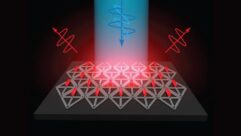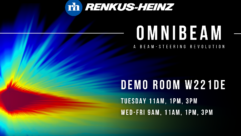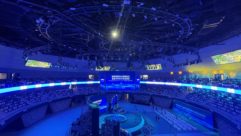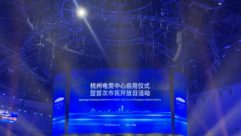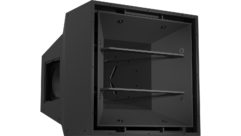The Science Of Line Arrays
With the right education, today’s modern tools, and sophisticated calculation software, there’s relatively little guesswork required to successfully fly a line array and achieve consistent coverage every time.
The basicsDialing it inDesign aidesTools of the tradeGet trainedArt and science
Nothing has caused more confusion in sound reinforcement than the loudspeaker design known as the line array. Why do we even call it a line array anyway, when most implementations are anything but a line, instead appearing as an elongated letter “J” or “C”?
A true line source would indeed be a straight line, but that’s not very practical. The curve usually found in line arrays addresses the problem of covering the entire audience, including listeners in the front rows of a venue. Although not technically correct, for the purpose of this article we’ll use the term “line array” to include curvilinear arrays. We’ll also assume that a line array is intended to refer to a system of multiple individual line array elements (enclosures) that are specifically designed for arrayability.
A line array is a set of radiators (loudspeakers) with spacing that meets very specific criteria that causes the whole array to exhibit greater pattern control (directivity) in the direction of the line. It also causes the rate of decay of the level of the sound (SPL) to become less than the inverse square law predicts. Using a theoretically correct line array, the sound would exhibit 3 dB attenuation for each doubling of distance rather than 6 dB. But because we don’t do audio in a perfect world, this apparent breaking of the inverse square law is not what it seems on the surface. (Note: Implications of this reality are beyond the scope of this article.)
While line array products are relatively new, the concept is not. First described more than 60 years ago, the technology has only recently been produced in a large-scale implementation. Sophisticated computer modeling applications have allowed engineers to create systems in the virtual domain, making it practical to test multiple design iterations without exhausting R&D resources. Additionally, the ability to model loudspeaker components such as HF phase manipulation devices and waveguides drastically shortens development time.
Why do we use line arrays in so many audio applications? In the most practical sense, there are three main benefits of doing so, including:
- The ability to reduce the level of sound off ceilings or any other object above the listening area as well as beneath and behind the loudspeaker array.
- Greater “throw” and more consistent SPL from front to rear.
- No “lobing” in the horizontal plane caused by adjacent loudspeakers because there are no horizontally adjacent loudspeakers in the array.
When can I use a line array?
The best use of a line array is when the horizontal coverage requirements for the event match the horizontal coverage of the loudspeaker system. The nominal horizontal coverage of these systems ranges from around 90 degrees to 110 degrees or more. Because there are no adjacent loudspeakers in the horizontal plane, it’s not possible to dial in the horizontal coverage by adding another column of loudspeakers. However, it is common practice to use a second line array behind and to the side of the primary array to cover the audience areas outside its coverage pattern.
There is no rule of thumb regarding which type of line array format (small, medium, or large) is more appropriate for a given application. As always, venue characteristics, sightline requirements, and client demands dictate the solution. However, it’s common practice to use smaller format loudspeakers for speech-only applications and medium to large formats for high SPL requirements. This is not to say you can’t do rock and roll with a small-format system (particularly with a suitable subwoofer system). Conversely, large speech-only events with appropriate facilities may use a large-format system.
Once you select the format, if event characteristics allow the use of a line array, you can:
- Control the vertical coverage angle to the extent of aiming the array at the floor in the rear of a venue (a hotel ballroom, for example) or at the top seat in an arena.
- Get higher gain before feedback onstage or at the podium.
- Have more consistent SPL from front to rear.
Pattern control in the vertical plane
Understanding pattern control is a key concept for AV systems designers and installers using line arrays. The general rule is: The longer the line, the more pattern control (directivity) you get, which in this case means a narrower overall pattern in the vertical plane. Greater pattern control obtained by increasing the length of the line is what allows you to greatly reduce the amount of sound reflecting off the air wall at the back of the hotel ballroom or at unused seats high up in an arena. For outdoor applications, vertical pattern control allows you to focus sound on the audience without wasting energy in the air where no one is sitting.
For most line array implementations, you need at least four boxes to realize any of the benefits associated with these systems. Even then, you may be able to get the same coverage with a conventional system. A minimum of six boxes is typically appropriate, but you really want to fly as many as you can. The increased pattern control from the longer line gives you more gain before feedback at the podium and a greater reduction of SPL behind the array. The very nature of line arrays causes them to radiate less sound in the rear than conventional loudspeaker arrays, and by building as long a line as possible, the spill onto the stage or into monitor world is greatly reduced.
A proper line array implementation causes the SPL to be equally distributed by virtue of array construction, without changing levels of individual elements within the array. If properly constructed, there should be no need to change levels of individual boxes. It’s all about distributing equal power to all areas by varying the arc of the array.
Line array loudspeakers have very narrow nominal vertical coverage per box (usually between 3 and 12 degrees), and the SPL at a given distance is primarily controlled by the angle between adjacent vertical boxes. Some have no physical angle at all (i.e., no trapezoid shape). However, the physical shape of the loudspeaker is not nearly as important as the angle applied between each in the array. For example, by using no angle or very small angles between the loudspeakers at the top of the array, summation over a small portion of space causes that part of the system to have greater “throw.” Increasing the angles as you go from top to bottom, and thus from the rear of the audience to the front rows, causes summation over a wider portion of space and lowers the SPL accordingly. Therefore, if a proper design is employed, the SPL distribution over the audience area should be consistent. The varying arc of the array determines both coverage and SPL.
Because these are precision devices, even a slight error in setting the inter-box angles can cause problems. If the angle is too small, there will be a hot spot of noticeably higher SPL. Conversely, too great of an angle causes lower SPL for that area. Either mistake introduces inconsistencies in coverage.
If predicted SPL is insufficient for the application, add loudspeakers to the array if possible. Conversely, if sufficient SPL is available but you encounter difficulty obtaining consistent SPL over the audience area, consider removing loudspeakers until it becomes even. It’s common for very small adjustments in array height, tilt, and inter-box angles to drastically change the coverage, particularly in the rear of the venue. If the array height is dictated by sightline or other requirements, sometimes the only way to get even coverage is to remove one loudspeaker at a time until the coverage becomes even within these parameters.
Using Array Calculators
The typical process for using an array calculator is:
- Determine the rigging points for the array.
- Determine where the vertical coverage starts and edns (the front rows to the rear of the venue).
- Take physical venue measurements using a laser range finder and a clinometer.
- Plug this data into the calculator software.
- Adjust the software parameters (array height, array angle, inter-box angles, and number of loudspeakers) until a desirable solution is found for both SPL and coverage.
If you have control over the trim height of the array, you’ll find that getting even coverage at the desired SPL is a balancing act between the number of loudspeakers, inter-box angles, tilt of the array, and trim height. To keep the line as long as possible and gain the associated benefits, try to optimize coverage and SPL by first changing the angles and trim height.
Many line array calculators offer mechanical data regarding the safety of the proposed array configuration. As more and more tilt is applied, the mechanical forces on the rigging hardware change drastically. In fact, it’s possible to get into a potentially unsafe condition by using extreme tilt. Always consult the mechanical data presented by the software before constructing the array; for a summary of the typical process, see the “Using Array Calculators” sidebar below.
Fortunately, most line array manufacturers provide software to determine how to hang the array. But keep in mind that each program is specific to that particular line array and will not work for other products. Similarly, there are no generic line array calculators that work for all systems. Some are spreadsheet based; others are written in a programming language. In any event, it’s not possible to produce a proper implementation without using the software specific to each loudspeaker system (see table on page 54 for more information).
An installation can benefit greatly from the predictions offered by EASE or other similar modeling programs that have data for the specified loudspeaker system. The modeling process for line arrays is no different than modeling rooms and predicting performance using conventional systems.
While it’s possible to use a program such as EASE to get a feel for what will happen in advance of a live event, this only works if the exact characteristics of the venue (and the exact placement of the rigging points) are known in advance. Additionally, the rigging points must go exactly where EASE or other prediction programs think they are. For the majority of live events, this advance work is of dubious value except for the most high-profile events for which these parameters can be specified along with assurance that the PA goes exactly where the plan says it goes. If you have to move the PA to accommodate a video screen (that never happens, right?), your plans are useless. Plus, you still have to run the line array calculator software to get trim height and inter-box angles. Once you learn how to use this software effectively, it should take a very short time to come up with a solution on-site.
It’s common for line array calculator software to allow the creation of a side view of the venue, so you can visualize floor rake, balconies, and various levels in the facility. It generally takes a little bit of practice to become proficient at “drawing” these architectural features, but it’s worth it — particularly for balconies because the areas underneath are often shaded from the PA. By entering an accurate representation of the venue, you can determine what will happen underneath the balcony and plan accordingly for supplemental coverage. Some program “wizards” determine optimum box count while others don’t. Even if your software recommends a specific number of loudspeakers, you must carefully scrutinize the predicted results to determine if the array is performing as predicted.
To implement these systems properly, two pieces of measurement equipment are essential: a laser range finder and a clinometer. A simple range finder, such as a Bushnell Yardage Pro (a type of device golfers use), is sufficient. Brunton and Suunto manufacture analog clinometers that are perfectly suitable for the application.
The range finder’s purpose should be obvious. The clinometer is used to determine the angle between the point directly below the loudspeaker array and the top of the coverage area in the rear of the venue. This point could be on a stage, if the PA hangs over the stage as in a theater. It could be (is normally) on the floor in an arena or similar venue when the PA doesn’t hang over the stage. If it’s on the stage, you have to factor that into the equation when entering data into the software. Basically, the angle and the distance yield the height of the rear of the coverage area.
When both the angle and distance are known, a simple calculation yields the height of this point relative to the origin of the measurement directly below the array. Each of these numbers is used in various ways by the array construction software to predict coverage and SPL.
An even better tool kit includes a clinometer and laser that are part of the loudspeaker array. These devices may be mounted on the bumper or sometimes inside the top loudspeaker in the array. After assembling the array with the inter-box angles specified by the software, the remote clinometer allows the user to apply the exact amount of up or down tilt to implement the desired coverage. And the remote-controlled laser allows the user to spot the rear of the venue, giving assurance that the array trim height and tilt have been implemented properly. If the software recommendations are properly followed, it’s very common for the laser to hit a spot that is very close to the predicted end of coverage. A few small adjustments with the chain motors from which the array is hung can put the coverage in exactly the right spot. If it’s possible to walk through the pattern in the vertical plane (such as in the rear of an arena), the point at which coverage begins to drop off should be quite obvious.
Because it’s essential to understand the operating principles of line arrays, most manufacturers offer classes on line array theory instruction. The remainder of the class should be on software usage and practice in array assembly and suspension. While it’s possible to do a proper implementation without attending a class, being trained by someone well versed in the operation of your system is unquestionably the best way to learn.
So where does the “art” come into this process after you deal with all of the science involved in properly flying line arrays? It really doesn’t figure into the equation at all. It’s safe to say that with adequate education, today’s modern tools, and sophisticated calculation programs, there is relatively little guesswork required to achieve the benefits of a properly implemented line array system.
These are high-precision devices that require aiming, and there is one way to get it right: Use and trust the software. It would be highly unlikely for a user to arbitrarily apply parameters such as inter-box angles successfully without the software. Will it make sound? Yes. Will the coverage be even and predictable? Almost certainly not. If you detect gross inconsistencies in coverage, you probably made a mistake with the software.
To avoid such pitfalls, practice using your calculator software. While most are fairly easy to use, these programs generally require practice to quickly generate a correct solution. Also keep in mind why you’re using a line array in the first place. Build the longest line you can with the given venue/show parameters. By doing this, you increase the directivity of the array. These are powerful tools when implemented properly, and in order to maximize the benefits, always follow manufacturers’ recommendations for array planning, assembly, and suspension. If you do so, you’ll experience greater intelligibility, more consistent coverage throughout the audience area, and less spill onto the stage — not to mention you’ll have a satisfied customer and a better show.
Doug Fowler is a freelance audio engineer based in Cape Girardeau, MO. He can be reached at [email protected].


